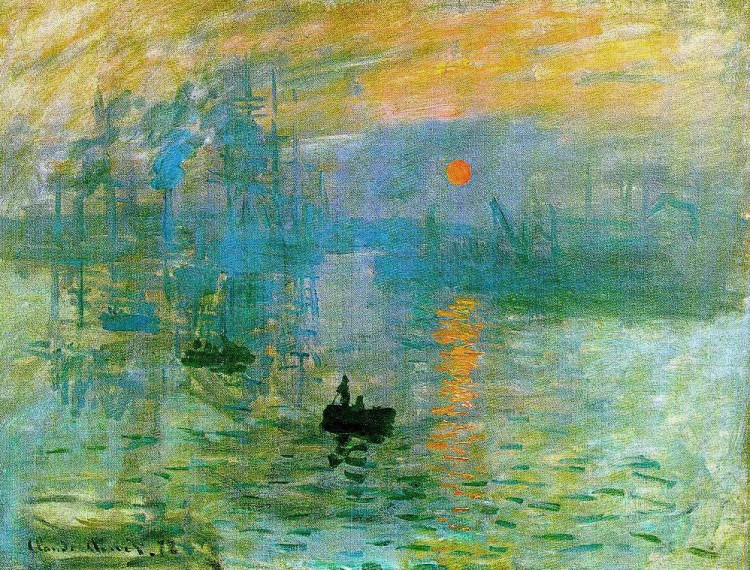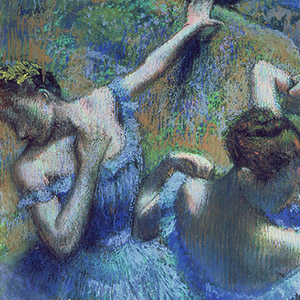[su_panel background=”#8523E1″ color=”#ffffff” border=”1px none #cccccc” shadow=”0px 0px 0px #eeeeee” radius=”1″]The Rise of the Impressionists[/su_panel]
Today we think of the French Impressionists as being a pretty traditional group, but when they began meeting together and producing their work in 1872, the world was amazingly different; so different that it’s hard for us to understand. These artists were revolutionists!
Before the 1860s…
Art had been acedemic.
Like a carefully manuscripted play, art had always been part realism, part classroom, and part idealism. Painters had only recently begun to paint the world around them as it actually appeared, and it was still a radical thing to do. Landscape paintings, for instance, had not been acceptable as just beautiful work on it’s own. They were supposed to depict history, mythology, or religious principles. Everything was highly staged.

[divider border=”small”]Art had been smooth.
To see a brush stroke, or paint that was thick and textural, was a sign that the artist was not skilled.
Art had been controlled.
Artists could only show and sell their work at certain Salon exhibitions. If you weren’t in these, you were a nobody. However, many younger artists were fighting the salon establishment. There were several groups rebelling against the staus quo. These groups became known as “the advanced guard” or “avant-garde” and were trying very new ideas.
The world was changing.
This was the time of the industrial revolution and the rise of the first middle class in France. Photography had recently been invented. Everything was different.
The Independents
Along came a group of painters from various backgrounds who met with each other often in the Paris cafes. Since their work was mostly rejected by the official salon, they soon decided to have their own exhibitions. There was no formal organization but they referred to themselves as the independents. They even had a woman join their group, which was shocking to many art critics. A woman could not paint in public or even attend certain art events.
Derision
Critics had no good things to say when they first viewed the independents’ work. The first painting exhibited by Monet was derided in print. The painting was titled, “Impression: Sunrise”, but the critic used the title sarcastically, saying it must be called “impressionism” and that it was not finished. How ironic that 150 years later, the world reveres Monet and his work, as well as the movement we call Impressionism, yet no one remembers the man who coined the term (poor Louis Leroy).
Other critics said they were “lazy”, that they must have a “disease of the eyes”, and that their figures looked “like decomposing flesh”. They were not kind.

Monet’s first impressionist painting, “Impression: Sunrise”
[divider border=”small”]The ideas of the Impressionists
The passing moment
They wanted to capture things in a way that a camera did. People half-way through an action, caught unaware. They did not want staged roman ruins with goddesses. They wanted to paint feelings and the lives of ordinary people.

Close up of a Renoir
[divider border=”small”]Out in the open, “en plein air”
Begun a few decades before, landscape painters had moved outdoors to make some painted color sketches before going back to their studio to paint the real thing. Now the impressionists were taking this a step further and doing the entire painting outdoors. They had to paint fast and mix less. The sketch was elevated to an art form.

Color
The impressionists had the advantage of using several new and brighter pigments that were just invented. They worked hard to create a sense of light and brilliance they saw when they went outdoors. Painters had always painted in dim studios, and on dark-colored surfaces before. Now the impressionists began painting in the light, and they used white or cream colored canvas to paint on. It was truly a color revolution.
Complimentary colors
With the exception of Eduard Manet, who is not considered a pure imporessionist, the artists stopped using black to mix into their colors altogether. Instead they developed the use of blending opposites to create shadow colors, or placing pure, brilliant, bits of opposite colors next to each other right on the canvas. The resulting effects made their color vibrant and intense.
 Degas pastel of dancers.
Degas pastel of dancers.

